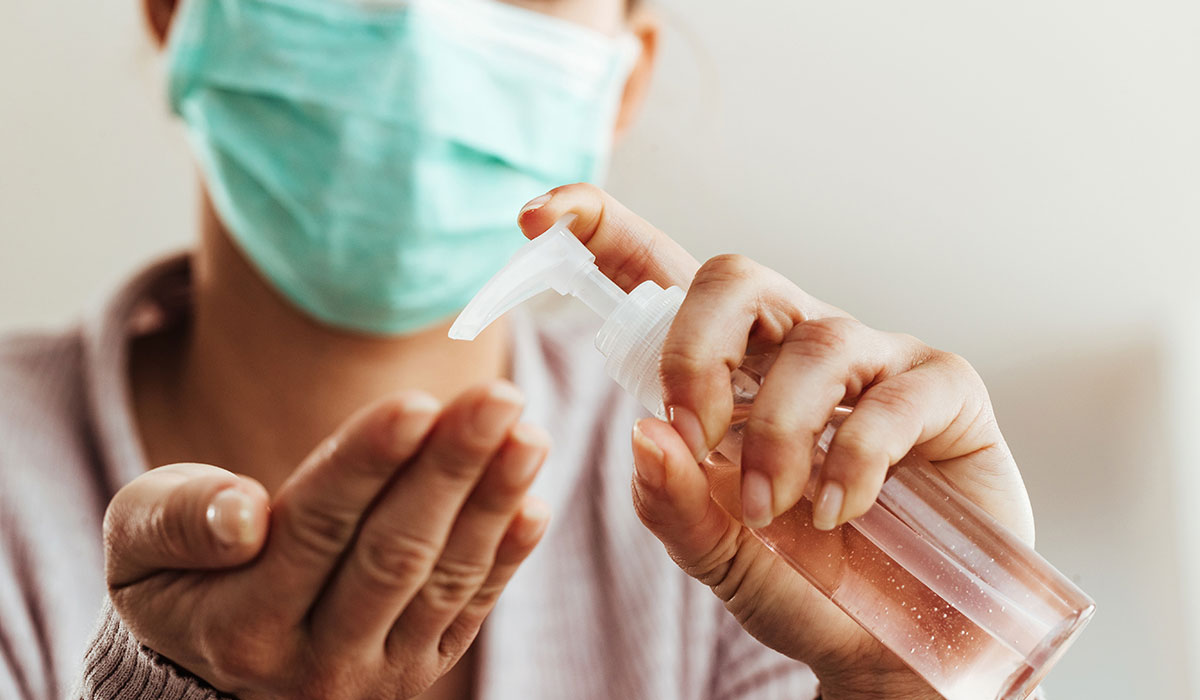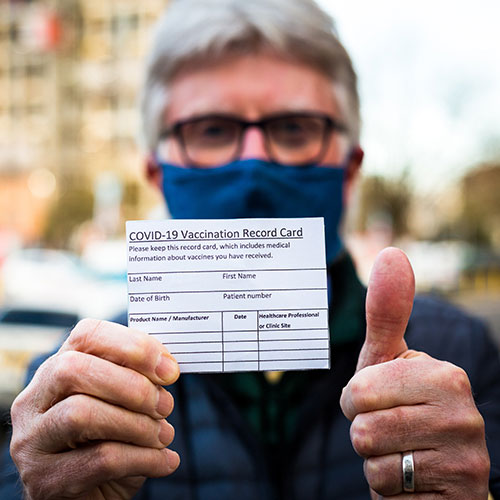February 2024
COVID-19 is a respiratory disease caused by a virus discovered in late 2019. The WHO declared COVID-19 a global pandemic in March 2020 — then declared an end to the global health emergency in May 2023. However, COVID-19 still is circulating and can cause serious illness. Being aware of symptoms and effective prevention strategies can help protect you and others from COVID-19.
How does COVID-19 spread?
COVID-19 spreads from one person to another through droplets or aerosols containing the SARS-CoV-2 coronavirus. Aerosols are extremely tiny droplets that are light enough to float through the air.
The most common way the disease spreads is through contact with someone who has an infection, even if they don’t have symptoms or know they are infected. Someone with a COVID-19 infection releases droplets and aerosols containing the virus when they cough, sneeze, talk, sing, or simply exhale. Many of these droplets fall to the ground within about six feet of the infected person, but others linger in the surrounding air and can travel on small air currents in a room.
If these droplets reach your nose, mouth, or eyes — or if you inhale the aerosols — they can cause an infection. Less often, you might become ill if you touch a surface where infected droplets fell, then touch your nose, mouth, or eyes.
Scientists don’t know how many droplets or aerosols are necessary to cause an infection. COVID-19 is more contagious than the flu, but not as contagious as measles. People become contagious a few days before they first experience a fever or any other symptoms.
COVID-19 symptoms
People can begin feeling COVID-19 symptoms anywhere from two to 14 days after exposure to the virus. Most people start feeling symptoms about four to five days after exposure.
These are the most common symptoms of COVID-19:
- Fever or chills
- Cough
- Shortness of breath or difficulty breathing
- Fatigue/tiredness
- Muscle aches or other body aches
- Headache
- Loss of sense of taste or smell
- Sore throat
- Nasal congestion or runny nose
- Nausea or vomiting
- Diarrhea
Sometimes people may experience other less-common symptoms. For example, some COVID-19 variants can cause pink eye, particularly in children. Others with COVID also have experienced brain fog, dizziness, confusion, tinnitus, numbness or tingling, loss of appetite, difficulty sleeping, or a flat rash on the fingers or toes.
COVID-19 typically lasts one to three weeks in most people, but some experience long-term effects for many weeks or even months, known as long COVID. Researchers estimate that 1-in-7 people in the U.S. have had long COVID. The most common long-term effects include fatigue, shortness of breath, cough, joint pain, and chest pain.
Approximately one in five people with a COVID-19 infection are asymptomatic and never develop symptoms. However, infected people without symptoms still can transmit the virus.
Risk factors for serious disease
People of any age can develop COVID-19 after exposure to the virus, and people of all ages have died from it. However, some groups are more likely than others to suffer severe cases of the disease, complications, or death.
The risk of a serious COVID-19 infection increases with a person’s age, with older adults carrying the highest risk of being hospitalized or dying from the disease.
For example, people ages 50 to 64 are three times more likely to be hospitalized and 25 times more likely to die from COVID-19 than people ages 18 to 29, people ages 75 to 84 are 140 times more likely to die from COVID-19 than people ages 18 to 29, and people ages 75 to 84 are 220 times more likely to die from COVID-19 than people ages 18 to 29.
People with certain preexisting conditions, listed below, also have a higher risk of severe disease or death from COVID-19:
- Type 2 diabetes
- Obesity
- Cancer
- Smoking
- Pregnancy
- Down syndrome
- Sickle cell disease
- Chronic kidney disease
- Chronic obstructive pulmonary disease (COPD)
- A weakened immune system from an organ transplant
- Heart conditions, such as heart failure or coronary artery disease
- Developmental or behavioral disorders
- Substance use disorders
Treating COVID-19
If you test positive for COVID-19, you may be able to reduce the disease’s severity and speed up your recovery by taking Paxlovid, a prescription medication approved by the FDA to treat mild to moderate COVID-19 in adults and teens who have a high risk of developing severe illness, including hospitalization or death. People must be age 12 or older and weigh at least 88 pounds to take Paxlovid.
Paxlovid comprises two antiviral drugs taken together: nirmatrelvir and ritonavir. Nirmatrelvir prevents the SARS-CoV-2 virus from entering uninfected cells, and ritonavir boosts nirmatrelvir’s effectiveness. Paxlovid involves taking three tablets (two nirmatrelvir and one ritonavir) twice a day for five days.
Studies have found that Paxlovid reduced the risk of hospitalization or death from COVID-19 by 88%. Paxlovid should be taken within the first five days after symptoms appear because it works best early in the course of an infection.
Who can get a Paxlovid prescription?
To get a Paxlovid prescription, you must be in a group with an increased risk of developing a severe case of the disease. This includes people ages 50 and up and those with an underlying health condition, such as diabetes, obesity, cancer, high blood pressure, or other conditions that increase risk of COVID-19 complications. Your doctor or a healthcare provider at a telehealth or urgent care appointment can determine whether you are eligible for Paxlovid and write a prescription.
You may be required to provide labs before receiving the prescription to ensure your kidney and liver functions are normal. People who cannot take Paxlovid include those with chronic kidney or liver conditions, people who have intolerance to lactose or galactose or have a lactase deficiency, and people with a previous allergic reaction to Paxlovid.
Be sure to tell your healthcare provider about any medications and supplements you are taking so they can be sure Paxlovid does not interact with them.
Information about taking Paxlovid while pregnant is limited, but one small study found no increased risk of complications during birth or for the baby when taken during pregnancy.
Some people who take Paxlovid may experience a “rebound” illness, in which they test positive for COVID-19 two to eight days after finishing their course of Paxlovid. If you experience rebound disease, you are still contagious to other people, so you should avoid being around others or wear a mask when around others to protect them. People who experience a rebound illness are advised not to take another course of Paxlovid.
Are there any alternatives to Paxlovid?
Another antiviral medication approved to treat COVID-19 is molnupiravir, sold as the brand name Lagevrio and taken as four capsules every day for five days. Molnupiravir is recommended for mild to moderate COVID-19 in people at high risk for severe disease when Paxlovid is not available. Molnupiravir is only available for people ages 18 and up and is not recommended during pregnancy.
Reduce your risk of catching COVID-19
There are several ways to reduce your risk of a COVID-19 infection, the most effective of which is to get vaccinated against COVID-19. The COVID-19 vaccine reduces your risk of infection, but it is still possible to develop COVID-19 even if you are vaccinated. However, if you develop COVID-19 after vaccination, your risk of severe complications, hospitalization, and death are still lower than if you never received the vaccine.
The second most effective way to reduce your risk of COVID-19 is to avoid people who have symptoms and avoid large gatherings of people from outside your household, particularly in small or crowded places with poor ventilation. Indoor gatherings are one of the most common sources of new infections. Opening windows and using fans and high-quality air filters can help improve indoor ventilation and reduce the risk of virus transmission.
If you will be around others outside your household, particularly in large groups indoors, you can reduce your risk of COVID-19 by wearing a surgical mask or an N95, KN95, or KF94 mask. Wearing a mask helps protect you from aerosols and protects others if you have an infection. Research has found that an N95 mask is the most effective, followed by KN95 and KF94. Surgical masks and cloth masks are not as effective at preventing COVID-19 as N95s, KN95s, and KF94s, but they still provide more protection than not wearing any mask.
Other preventive measures include washing your hands frequently with soap and water or using a hand sanitizer containing at least 60% alcohol. Also, regularly disinfect any frequently touched surfaces.



